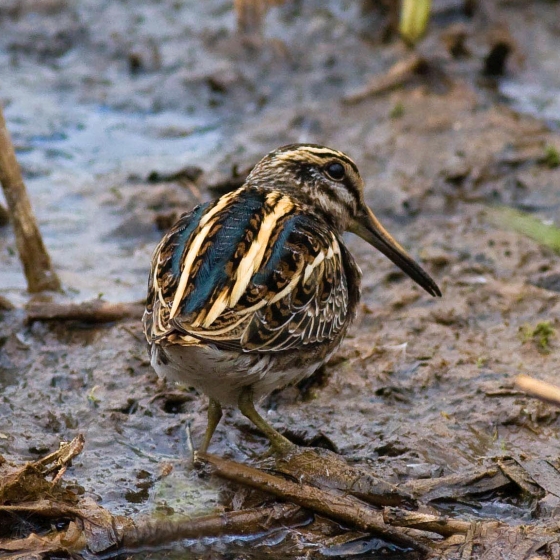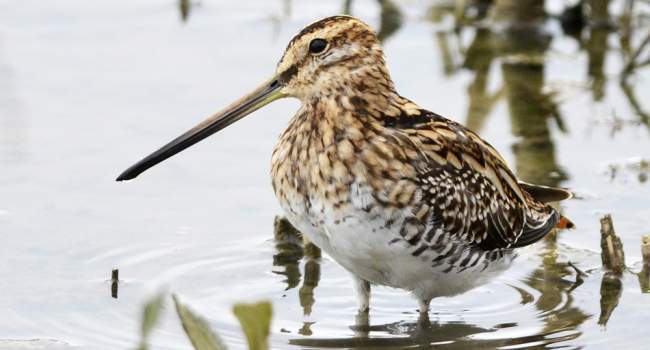Jack Snipe
Lymnocryptes minimus (Brünnich, 1764)
JS
 JACSN
JACSN  5180
5180

Family: Charadriiformes > Scolopacidae

Much smaller than Snipe this winter visitor is seldom seen, its patterned plumage providing perfect camouflage in marshy grassland.
Also called the ‘half-snipe’ because of its smaller size, this species is a winter visitor, with most birds reported from October through to April. Historically hunted alongside Snipe, it was less popular sport thanks to its habit of flying quickly back to the ground.
Similar to the Common Snipe in behaviour and habits, Jack Snipe is almost certainly commoner than most realise. Only a few WeBS counts manage double figures but atlas projects show records are widely distributed across the UK.
Identification
Jack Snipe identification is often straightforward. The following article may help when identifying Jack Snipe.
Identifying Common Snipe and Jack Snipe

A stocky brown bird rockets up from just in front of your feet, but is it a Common Snipe, or its rarer relative Jack Snipe? Let us help you tell the two apart.
SONGS AND CALLS
Listen to example recordings of the main vocalisations of Jack Snipe, provided by xeno-canto contributors.
Song
Develop your bird ID skills with our training courses
Our interactive online courses are a great way to develop your bird identification skills, whether you're new to the hobby or a competent birder looking to hone your abilities.
Browse training coursesStatus and Trends
Population size and trends and patterns of distribution based on BTO surveys and atlases with data collected by BTO volunteers.
CONSERVATION STATUS
This species can be found on the following statutory and conservation listings and schedules.
DISTRIBUTION
Wintering Jack Snipes are associated with the coastal fringe and damp lowland wetlands and occur throughout the UK. Their secretive nature means they are probably under-recorded in many areas.
Occupied 10-km squares in UK
| No. occupied in winter | 1217 |
| % occupied in winter | 40 |
European Distribution Map
DISTRIBUTION CHANGE
Since the 1981–84 Winter Atlas, the number of occupied 10-km squares has increased by 71% in Britain, but by only 29% in Ireland, a difference that may stem from the greater number of observers in Britain.
| % change in range in winter (1981–84 to 2007–11) | +68.8% |
SEASONALITY
Jack Snipes are winter visitors, present from late September to April.

Movement
Information about movement and migration based on online bird portals (e.g. BirdTrack), Ringing schemes and tracking studies.
RINGING RECOVERIES
View a summary of recoveries in the Online Ringing Report.
Foreign locations of birds ringed or recovered in Britain & Ireland

Biology
Lifecycle and body size information about Jack Snipe, including statistics on nesting, eggs and lifespan based on BTO ringing and nest recording data.
SURVIVAL & LONGEVITY
View number ringed each year in the Online Ringing Report
Maximum Age from Ringing 
|
9 years 4 months 17 days (set in 1981) 
|
BIOMETRICS
Wing Length 
|
Adults | 115.5±3.6 | Range 110–121mm, N=217 |
| Juveniles | 115.1±3.4 | Range 110-121mm, N=160 |
Body Weight 
|
Adults | 58.7±8.1 | Range 47.0–73.0g, N=192 |
| Juveniles | 56.5±7.7 | Range 45.5–69.6g, N=148 |
Feather measurements and photos on featherbase 
CODES & CLASSIFICATION
Ring size 
|
B+ |
Field Codes 
|
2-letter: JS | 5-letter code: JACSN | Euring: 5180 |
For information in another language (where available) click on a linked name
Links to more studies from ConservationEvidence.com
- Rush cutting to create nesting patches for lapwings Vanellus vanellus and other waders, Lower Lough Erne RSPB reserve, County Fermanagh, Northern Ireland
- Multifunctional benefits of an agri-environment scheme option: riparian buffer strip pools within 'arable reversion'
- Experimental removal of introduced hedgehogs improves wader nest success
Read more studies about Jack Snipe on Conservation Evidence >
Would you like to search for another species?










Share this page